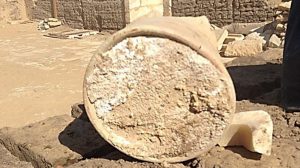
A look inside the ancient Egyptian tomb containing really old cheese
By Katherine J. Wu
Last month, archaeologists cracked open a tomb excavated in Alexandria, Egypt, revealing three skeletons bathing in an crimson pool of sludgy sewage. In response, tens of thousands around the world immediately petitioned for the right to sip from the freshly uncorked casket of amontillado (a sherry wine). (Spoiler: It hasn’t worked out.) But fear not, coffin connoisseurs: There’s a new artisanal artifact in town—the world’s oldest solid cheese, over 3,000 years in the making.
The tomb of Ptahmes, mayor of Memphis, the ancient capital of Egypt during the 13th century BC, contains quite the trove of treasures. First uncovered in 1885, the site was then lost to time for over a century. But between 2013 and 2014, Cairo University archaeologists rooting around the grave stumbled across a few broken jars with puzzling contents. One had remnants of a solid, whitish mass, as well as a canvas fabric the researchers speculate may have covered the jar when it was whole—perhaps to preserve its contents.
To unveil the nature of the mysterious mass, the researchers, led by Enrico Greco, a chemical scientist at the University of Catania in Italy, dissolved the substance and analyzed its contents.
The lump still contained a few recognizable bits of proteins, including casein from both cow milk and either sheep or goat milk. Since the cloth covering wouldn’t have kept a liquid from spilling out, the researchers reasoned that they were probably dealing with a solid dairy product, rather than, say, an old bottle of very spoiled milk.
Normally, an unidentified cheesy object would be confirmed with an analysis of its fats, Greco said in an interview with Ruth Schuster at Haaretz. But “aggressive” environmental disturbances, including several floodings from the nearby Nile and heavy rainfall, may have contaminated the gravesite with foreign chemicals. This kind of contamination likely destroyed most of the fats in the jarred substance over the course the last 3,200 or so years it endured in the tomb.
Traces of dairy have been found on artifacts as old as 7,000 years, constituting sufficient evidence for ancient cheesemaking, but this is the first sizable hunk of the tasty concoction to be found in any kind of preserved state.
The cheese was far from alone in this jar, however. The team was unsurprised to find traces of bacterial proteins in the knob of decayed cheese as well; after all, microbes are an essential part of fermenting dairy. But the microscopic critters that had blossomed upon this cheese weren’t the friendly Lactobacillus species that give Swiss and Emmental cheese their pleasantly nutty tang—or anything else you’d want near your food. That is, unless you have a bit of a death wish.
It turns out this antique cheese had a blood- (and milk-) curdling secret: a possible infestation of Brucella melitensis, a species of bacteria that causes the infectious disease brucellosis, which comes with a whole set of kicky symptoms including fever, sweating and muscle pain. Unsurprisingly, eating or drinking unpasteurized or raw dairy products is one of the most common ways to contract Brucella.
But matching bits of proteins to actual foods and living creatures is a bit like guessing the title of a book based on just a couple sentence fragments. Sometimes the words are distinct enough to make the connection; other times, they’re so ubiquitous that they could belong to just about any piece of writing. The researchers’ findings are somewhere in the middle: They think that this is some highly overmatured cheese—the Brucella is somewhat more dubious. If confirmed, though, this could be the oldest evidence yet that Brucella plagued ancient populations. Until now, brucellosis has only been identified in human remains dating back to 750 BC.
Even if it wasn’t Brucella, though, only so many microbes carry the particular protein the researchers identified. One of the other options, Coxiella burnetii, is also no walk in the park: This bacterium causes Q fever and also naturally infects a similar subset of livestock, resulting in similarly unpleasant ailments in humans. Based on their protein work, the researchers believe Coxiella is a far less likely suspect, but say that further confirmation is necessary.
In any case, with a hefty dose of decontamination, maybe this prehistoric cheese could pair well with a glass of ancient wine. And if given the opportunity, the people will likely make an understandable stink for the chance.




Pingback: Calcannabis Canvas - My Blog